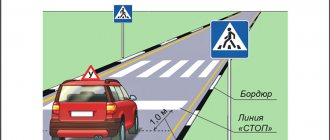Regulatory and legal framework
The main document regulating transportation is the “Road Rules”. Traffic rules 2021 were developed taking into account the shortcomings identified in previous editions. Compliance with them reduces the risk of traffic accidents, since uniform rules appeared in 1931. Since then, they have been supplemented and republished annually.
The fine for an excess passenger is established by the Code of Administrative Offences. This normative document approves the list of administrative crimes and regulates the procedure for bringing to justice for their commission.
Important! Violating the rules for transporting passengers easily leads to serious harm to health when involved in an accident, which threatens the driver with punishment in accordance with Article 264 of the Criminal Code of Russia.
Who issues the fine?
There are two ways to record a violation: stationary weight control and mobile control.
Stationary systems read weight automatically. To do this, the car doesn’t even need to stop - you can drive at speeds of up to 140 km/h. If the system notices an overload and does not find information about a special permit in its database, it will send data about the overload and a photo of the license plate to the traffic police. Next, the inspector will compare the car data with information about the owner and issue a fine.
Mobile systems are being deployed by employees of Rostransnadzor together with the traffic police. Supervision officers conduct an inspection, and the inspector issues a report if there is a violation. Rostransnadzor is guided by the rules of weight control.
Number of seats in the vehicle
As stated earlier in the article, the number of seats in the car is determined by its technical characteristics, or rather, indicated in the “Body” paragraph of the PTS.
Important! Recording in the “five-seater” format does not mean that it is allowed to transport five fellow travelers in a passenger car, since this number includes the driver himself, and the maximum number of passengers is 4 people.
Most passenger cars have exactly these characteristics, but the families of many Russian residents consist of a larger number of members, and everyone needs to be transported. It is possible to transport 6 or more people in one car even if the driver only has a category B license.
Expert opinion
Artemyev Dmitry
Experience as a forensic expert in the field of automotive technical examination for more than 2 years, more than 3 years of work in the field of insurance disputes, appealing guilt in road accidents.
Ask a Question
The fact is that such a license allows you to drive vehicles with eight passenger seats. The number of six-seater passenger cars on the Russian market is large; vehicles with a large number of passenger seats are also available to domestic motorists. For example, AvtoVAZ produces the Lada Largus and UAZ Patriot, and most foreign automakers supply multi-seat crossovers and minivans.
Main aspects
Drivers know that under no circumstances should a truck be overloaded, as this has a bad effect on the road surface and can cause damage to it, as well as deterioration in vehicle handling.
But the presence of such a requirement for trucks does not mean at all that a passenger car can be overloaded with various objects or carry extra passengers if the design of the car does not provide for additional seats.
If you look at the overloading situation from a road safety perspective, it is no safer than overloading trucks.
After all, a vehicle of any category can create an emergency situation and lead to human casualties.
It is not uncommon to see vehicles that have been loaded with too much weight end up in ditch, and this is the least of the dangers that can be caused by overloading.
Basic moments
Motorists who fill their car with cargo above a critical threshold sometimes do not even know that for exceeding the established weight limit they can receive a fine and do not even understand that they pose a danger.
Moreover, when the vehicle is overloaded, it can even visually demonstrate this: its shock absorbers sag, the steering is very unresponsive and heavier, and a broken frame, wheel or wheel that falls off is a common situation for a vehicle that has been driven with an excess load, especially if it is not new vehicle.
Extra passengers, whom the driver places in a car with too many seats, are also negatively assessed by law.
But this happens for the most part because it is impossible to ensure the safety of extra passengers, since even there may not be enough seat belts for them, and in the event of an accident or a vehicle rollover, an unbelted person may well die, and an exceeded total number of passengers can lead to panic and crowding. critical situation.
What is its meaning
Overloading even a passenger car is extremely dangerous, since it can lead to premature failure of its components, a significant deterioration in vehicle controllability, and of course, a driver, even an experienced one, will not always be able to cope with an overloaded car, which can go into a skid or otherwise enter in a non-trivial situation on the road.
Therefore, the traffic police closely monitors the road situation and the condition of cars so that they do not become the culprits of accidents.
The fine, which is issued to motorists for exceeding the maximum permissible weight, has a disciplinary function, accustoming drivers to responsibility even for such an offense as overloading a car, so that they cannot ruin the road surface and do not take too many passengers into the cabin.
This improves driving culture and reduces the risk of accidents due to vehicle breakdown or deterioration of its quality.
What regulations governs
Usually, articles of the Code of Administrative Offenses of the Russian Federation are responsible for imposing administrative fines, but Article 12.21.1 only mentions information about punishment for overloading trucks, and there is simply no data on what is due to a driver who has exceeded the limit of cargo or passengers in a passenger car, therefore, the general rule of Article 12.21 applies, which provides for a fine, but at the same time, other standards that regulate the operation of the car and its load capacity can be used.
For example, about passengers and their number is stated in the Traffic Rules, and their paragraph 22.8 is responsible for this.
It states that the number of passengers traveling in the car must match the characteristics of the car and the number of seats indicated in the technical documentation.
Thus, the driver can be punished under two articles at once - unfastened passenger and violation of transportation rules. In this case, the relevant clauses of the Code of Administrative Offenses of the Russian Federation apply.
Prohibition on the carriage of unnecessary goods in traffic regulations
The transportation of people in cars is regulated by Article 22.8 of the “Road Rules”.
It states that it is prohibited to move people:
- Outside the vehicle interior, except when using a body or trailer specially equipped for these purposes.
- In quantities greater than indicated in the technical specifications of the vehicle.
Please note that some vehicles allow the carriage of people standing and no fine will be issued for transporting excess passengers if their number does not exceed that specified in the PTS.
However, paragraph 3 of Article 22 of the Traffic Regulations indicates situations in which a person must be provided with a separate seat:
- When transported in the back of a truck.
- When the bus is driving in the mountains or on an intercity route.
- When transporting children in a group.
- When conducting excursions.
Rules for the transportation of goods by passenger car (transport).
According to the existing Code of Administrative Offenses, there is no regulated condition for the carrying capacity of a passenger car. But the basic rules for transporting a passenger car do not recommend overloading this vehicle, as this can affect the control of the car and its maneuverability; the basic permissible weight cannot exceed 350 kilograms.
Attention!
Transporting large items on the roof of a car has its own load limit - up to 90 kilograms for imported cars and up to 70 kilograms is the limit for the domestic automobile industry.
Items transported in the trunk must be distributed evenly over the entire area of the trunk. When the trunk is overloaded, you lose control of the car during sharp braking and the front part of the car skids when cornering, the rear bumper clings to the road surface.
In accordance with the rules for transportation by passenger car, the cargo transported must not block the driver’s view (including the rear view mirror) or interfere with the movement of other vehicles.
There will be no claims against the driver of a passenger car from law enforcement officials in case of overload only if:
- there will be no damage to the road surface;
- there will be stability of a passenger car;
- there will be no interference with the movement of the car;
- the speed of loaded vehicles will not exceed 100 kilometers per hour.
The transportation of people in a passenger car is strictly regulated in accordance with Section 22 of the Traffic Regulations. Clause 22.8 states:
- the number of passengers (no extra people) in the passenger car must match the technical specifications of the manufacturer;
- It is prohibited to transport people outside the passenger car;
- the passenger and driver of a passenger vehicle must wear a seat belt.
What does the fine consist of?
The penalty for transporting passengers in the cabin in excess of the norm is regulated by Article 12.23 of the Code of Administrative Offenses of the Russian Federation and is 500 rubles. The fine for overloading a passenger car with people transported outside the passenger compartment (trunk, hood, etc.) is 1,000 rubles.
Important! The amount of fines issued in accordance with Article 12.23 of the Code of Administrative Offenses does not depend on the number of passengers transported incorrectly, that is, for transporting four or five people in the back seat, the fine is the same.
Please note that the penalty for violating paragraph 8 of Article 22 of the Traffic Regulations is not limited to a fine. After all, the extra passenger carried in the rear is not wearing a seat belt, since the car simply does not have such an additional device. This means that the driver receives a punishment in accordance with Article 12.6 of the Code of Administrative Offenses, which imposes a fine of 1,000 rubles on the driver for an unfastened passenger.
Thus, the final amount of punishment could be:
- 1500 rubles for exceeding the limit of people on seats.
- 2000 rubles for incorrectly transporting passengers outside the vehicle
- 2500 rubles for transporting extra people simultaneously inside and outside the cabin.
Please note that if you are fined for having an extra person in the car, this does not mean that you can continue driving with overload; traffic police inspectors have every right to issue the order again, since the violation has not been eliminated.
From the video you will find out what fine a driver can expect for overloading a car:
Violation of a sign prohibiting the passage of trucks
The amount of the fine depends on the city:
- 5000 rubles - in Moscow and St. Petersburg;
- 500 rubles - in other cities of the Russian Federation.
Such a fine can be received by a driver who did not notice the sign “No cargo entry” and entered the third transport ring of Moscow at the wrong time - from 6 to 22 hours.
We wrote in detail about fines for driving under the “No Freight” sign.
Legal assistance and features of litigation
Litigation regarding the issue of overloading trailers of a passenger car (as well as a truck) are not the most frequent, because It is almost impossible to win a case if there is evidence of overload and avoid punishment. But it is possible to minimize the size of a possible fine; to do this, you should first consult with a car lawyer to assess all the chances.
Each situation is unique; in any case, detailed consideration and study of the issue is required. As described above, it is one thing to be fined simply for violating transportation rules, and quite another thing if a fraud is detected in the indicated weight of the transported cargo, which also turns out to be unacceptable in size or is one of those for which a separate permit must be obtained. Here, you can’t do without the help of a lawyer experienced in auto law. He will tell you what to do next, and in a difficult situation he will be able to defend you in court.
0
0
0
0
0
0
What is the fine for overloading a car in 2020?
On average, for overloading a passenger car, a fine of 500 rubles is imposed - this is the general requirement of the article of the administrative code, which stipulates such a fine.
At the same time, you need to understand how an inspector can determine that a car is overloaded, what instruments he can use for this, and also what overloading a car can lead to in different situations.
Moreover, you also need to understand whether the penalty for overloading may vary depending on the owner, because in the case of trucks, a legal entity bears much greater responsibility than the driver of the vehicle.
How an inspector determines the overweight of a car
If a motorist allowed more passengers to board than the car can accommodate, then there is no difficulty in determining the violation, because it is visible to the naked eye.
The inspector simply has to look at how many passengers the car is designed to carry and then count the number available.
In addition, this can be done by the number of seat belts, since extra people will not be able to buckle up and will be safe.
But if we are talking about exceeding the weight of the cargo, then the inspector has the right to record this fact visually, but there must be good reasons for this.
For example, if a load in a car obscures the driver’s view, and the car itself sags under the weight, then this may be a reason to impose a fine for allowing the vehicle to be overloaded.
The same applies to oversized loads that protrude beyond the vehicle and interfere with other road users; of course, this also includes situations in which the car is so loaded that the bumper touches the road surface, and this is damage to government property.
What is the danger of this load?
Despite the fact that higher penalties for overloading are provided for trucks, since they cause more damage to the road surface, and their getting out of control poses a greater threat, a passenger car with an excess load is also extremely dangerous.
First of all, the car loses stability on the road, and if you need to enter a sharp turn or brake sharply in front of a sudden obstacle, this can easily lead to a loss of control and the subsequent exit of the car from the driver’s control.
If the load is exceeded, the center of gravity of the machine shifts, which will also be dangerous.
If the load is concentrated at the rear, this can lead to increased skidding when cornering, and the car may even roll over or, losing control, crash into another vehicle.
If there is also a load on the roof, then the probability of a rollover increases significantly, since the center of gravity is at the top and with a sufficiently narrow wheelbase, a vehicle rollover becomes a reality.
An overweight car can sag, hitting the road surface with its bottom and bumper.
This not only ruins the asphalt, but can also cause damage to the car itself, since the bumper is usually scratched and may even fly off, and important components located on the bottom of the car can also be damaged.
In addition, shock absorbers, frames and other car components are also not without the risk of damage due to excess load, and if the road is of poor quality, then constant jumps increase the risk of their failure significantly.
Excess weight
As already mentioned, excess weight in a car can lead to poor handling and an emergency situation, but there are also additional inconveniences.
If the load is not securely secured, it can break off and hit vehicles behind, and its movements can rock the vehicle and cause it to roll over.
The braking distance of the car increases significantly, and if there is a need for an emergency stop, it will not be possible due to greater inertia.
If the load exceeds the dimensions of the vehicle, then the driver’s visibility, especially from behind and on the sides, deteriorates, which can also lead to an accident due to negligence; the load on the axles, as in trucks, does not play a role here.
Number of people in the car
Considering that car manufacturers prescribe the number of seats, this figure cannot be exceeded.
After all, this can not only violate the weight standards for a car, but also affect the safety of not only extra passengers, but also those who sit according to the rules.
For what the Code of Administrative Offenses says about the fine for overloading a truck for individuals in 2021, see the article: fine for overloading a truck for individuals. At what age do you get a license for a scooter up to 50cc, read here.
The fact is that the number of seat belts is pre-calculated taking into account the seats, and if a person is not fastened, then in the event of an accident he can move around the cabin and injure not only himself, but also other people sitting in the cabin.
In this regard, you need to know what the fine is for overloading a car with passengers.
Some drivers think that the seats in the car are specified taking into account only adult passengers, and with a permissible load of four seats, four people ride in the car and a child is seated on the lap.
Guided by logic, the driver believes that the child will be protected by the same belt that secures the adult, but in fact this is not the case, and the child takes up one full seat.
After all, the seat belt fastener is designed for one person, and in the event of an accident, its tension is carried out based on one body.
A child can suffer even more severe injuries in an emergency situation, because being held in place by a belt on one side and being pinned down by an adult on the other, they can suffer even more serious internal injuries as the pressure only increases.
Exceeding the weight of the trailer
When the weight of the trailer, that is, its load capacity level, is exceeded, the same problems are observed as when the vehicle itself is overloaded.
That is, the braking distance increases, since the trailer continues to move forward by inertia despite the efforts of the brakes, and if the need arises for maneuvering, the additional cargo structure will not be able to provide the necessary dexterity and will skid; in particularly difficult situations, the trailer can even carry the car into a ditch .
When overloaded, a trailer can place a strong load on the attachment to the car, and when turning or braking, it can simply collapse, and the trailer itself will crash into other cars.
Video: the dangers of overloading a car
Amount of penalty
Considering that different overloads are classified differently by the Code of Administrative Offenses of the Russian Federation, different punishments will be assigned for an extra passenger and for excess cargo.
Thus, you need to know what will be applied to different categories of drivers, and what penalties they can expect for such violations related to excess weight.
In this case, the fine can range from several hundred rubles to thousands, it all depends on its category and how the inspector classifies the offense.
For individuals
If the driver is an individual, that is, an ordinary driver, and the car does not belong to a legal entity, then when driving with a load whose weight exceeds the maximum load, he will be fined 500 rubles.
If it is discovered that the passenger capacity is exceeded, you will have to pay for two items at once - 500 rubles will be spent for the extra passenger, and another thousand rubles will be the actual punishment for overloading.
If, as described earlier, the driver is carrying another child who is on the passenger’s lap, then the fine for such an offense will be 3 thousand rubles.











